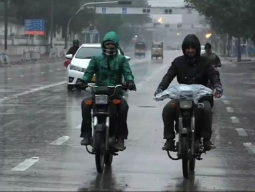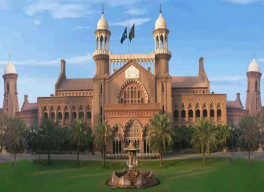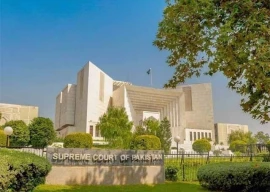
LAHORE: Lahore woke up to the coldest winter morning in 35 years as the temperature in the provincial capital was equivalent to Murree at 2°C early on Monday.
The Pakistan Meteorological Department (PMD) data showed that shivering low temperature of 2°C was recorded in Chakwal, 1°C in Attock and Dera Ghazi Khan, 2°C in Lahore, Murree, Rawalpindi, Multan and Bahawalpur, 3°C on Jhelum and 4°C in Sahiwal, Faisalabad and Sargodha.
Speaking to The Express Tribune, Chief Meteorologist Muhammad Riaz highlighted that the current chilly spell would continue till mid-January.
“Although climate change has some impact on weather patterns, there is nothing unusual. The coldest winter spell is witnessed from mid-December to mid-January every year,” he added.
Lahore reels under alarming level of air pollution
Weather reports issued by the PMD indicated that continental air is prevailing over most parts of the country and a shallow westerly wave is likely to affect the western and upper parts of the country from Tuesday (today).
It shows that rain or thunderstorm, with light snowfall over mountains, is expected in upper hilly areas of Khyber Pakhtunkhwa and Gilgit-Baltistan, while dense fog is likely to prevail in most plain areas of Punjab and upper Sindh and some plain areas of Khyber Pakhtunkhwa during night hours. It forecasts that cold and dry weather is expected elsewhere in the country while very cold in upper areas.
Hardly any sunshine was witnessed in the provincial capital and plain areas of Punjab from past few days, leaving plains of Punjab under dense fog blanket bringing the life to a standstill as poor visibility badly disrupted road, rail and air traffic in the country.
The National Highways and Motorway Police (NH&MP) issued warning on dense fog had forced closures of various sections of national highways and motorways across Punjab.
A spokesperson for the NH&MP warned road users to avoid unnecessary travel as visibility falls below 50 meters during the night. He advised citizens to drive carefully, avoid overspending, maintain a safe distance from vehicles ahead and consult the NH&MP helpline 130 for road conditions or use the NHMP’s Humsafar mobile app for quick information about major routes.
The Asian Development Bank’s Climate Change Profile of Pakistan report highlights that Pakistan potentially faces a major climate change challenge. A concerted effort by the government and civil society at all levels is required to mitigate these threats.
In the last 50 years, the annual mean temperature in Pakistan has increased by roughly 0.5°C. The number of heatwave days per year has increased nearly fivefold in the last 30 years.
Annual precipitation has historically shown high variability but has slightly increased in the last 50 years.
Sea level along the Karachi coast has risen approximately 10 centimetres in the last century. By the end of this century, the annual mean temperature in Pakistan is expected to rise by 3°C to 5°C for a central global emissions scenario, while higher global emissions may yield rise of 4°C to 6°C.
Average annual rainfall is not expected to have a significant long-term trend but is expected to exhibit large inter-annual variability. Sea level is expected to rise by a further 60 centimetres by the end of the century and will most likely affect the low-lying coastal areas south of Karachi toward Keti Bander and the Indus River delta.
Under future climate change scenarios, Pakistan is expected to experience increased variability of river flows due to increased variability of precipitation and the melting of glaciers.
Demand for irrigation water may increase due to higher evaporation rates. Yields of wheat and basmati rice are expected to decline and may drive production northward, subject to water availability.
Water availability for hydropower generation may decline. Hotter temperatures are likely to increase energy demand due to increased air conditioning requirements. Warmer air and water temperatures may decrease the efficiency of nuclear and thermal power plant generation. Mortality due to extreme heat waves may increase. Urban drainage systems may be further stressed by high rainfall and flash floods. Sea level rise and storm surges may adversely affect coastal infrastructure and livelihoods.
Adapting to these impacts may include: development or use of crop varieties with greater heat and drought tolerance, modernizing irrigation infrastructure and employing water-saving technologies, integrated watershed management, reforestation of catchment areas and construction of additional water storage, diversification of energy mix including investment in renewable and small hydropower projects, improved weather forecasting and warning systems, retrofitting of critical energy infrastructure, and construction of dykes or sea walls.
Lahore emerges as fourth most polluted city in world
It highlights that the National Climate Change Policy of 2012 is Pakistan’s guiding document on climate change, setting out the goal of achieving climate-resilient development for the country through mainstreaming climate change in the economically and socially vulnerable sectors of the country.
Approximately 6% of Pakistan’s federal budget during 2010–2014 comprised climate change-related expenditures, predominantly in energy and transport. As described in its Nationally Determined Contribution to the Paris Agreement under the United Nations Framework Convention on Climate Change, Pakistan intends to reduce up to 20% of its 2030 projected greenhouse gas emission, subject to availability of international grants to meet the cumulative abatement costs amounting to approximately $40 billion. The country’s adaptation needs have been identified to range between $7 billion to $14 billion per year.
Published in The Express Tribune, December 31st, 2019.






















































COMMENTS
Comments are moderated and generally will be posted if they are on-topic and not abusive.
For more information, please see our Comments FAQ